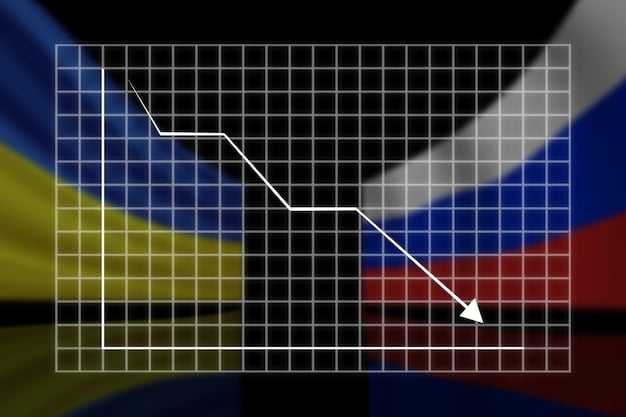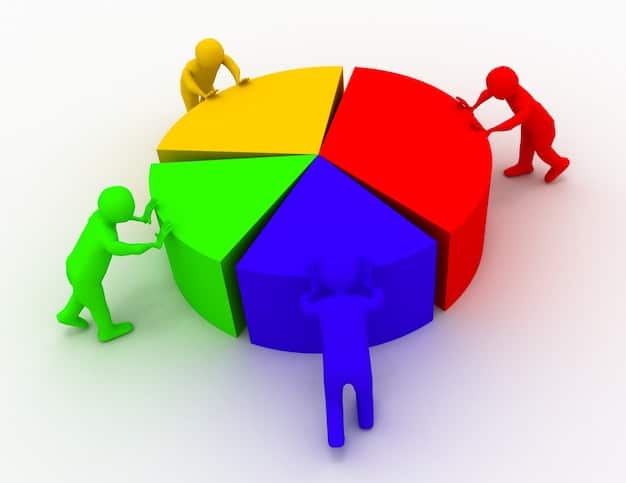La Liga’s US Surge: Stats Behind Its Growing Popularity

La Liga’s Growing Popularity in the US: A Statistical Breakdown reveals a significant rise in viewership, merchandise sales, and digital engagement, driven by strategic broadcasting deals, star power, and targeted marketing efforts appealing to a diverse American audience.
The beautiful game has found a new, fervent audience across the Atlantic, and La Liga is at the forefront. This article explores La Liga’s Growing Popularity in the US: A Statistical Breakdown, unraveling the key drivers behind its surging fanbase.
La Liga’s Rising Viewership in the US
La Liga has experienced a notable surge in viewership within the United States, signaling a growing interest in Spanish football among American audiences. This increase can be attributed to several factors, including strategic broadcasting partnerships and the rising global appeal of football.
The numbers tell a compelling story: major networks have secured broadcasting rights, making La Liga matches more accessible to US viewers. Furthermore, the league’s proactive marketing efforts have successfully tapped into the diverse American sports market, driving up viewership figures.
Broadcasting Deals and Increased Accessibility
One of the primary drivers of La Liga’s increased viewership is its strategic partnerships with major broadcasting networks in the US. These deals ensure that a significant number of matches are available to American viewers through both traditional television and streaming platforms.
- The ESPN deal provides extensive coverage of La Liga matches, including live games, highlights, and analysis.
- Streaming services like ESPN+ offer additional access to La Liga content, catering to the growing trend of online viewing.
- These partnerships have significantly increased the accessibility of La Liga, making it easier for American fans to follow their favorite teams and players.
These deals not only boost viewership but also contribute to the league’s revenue and overall popularity in the US, making it a win-win situation for all parties involved.

In conclusion, the strategic broadcasting partnerships and overall accessibility of La Liga matches have been pivotal in driving up viewership numbers in the US. This trend underscores the growing appeal of Spanish football to American audiences and its increasing competitiveness in the US sports market.
Merchandise Sales and Brand Recognition
Increased viewership naturally leads to greater brand recognition and, consequently, higher merchandise sales. La Liga’s growing popularity in the US is mirrored in the rising sales figures of team jerseys, scarves, and other related merchandise.
The presence of star players and iconic clubs further fuels this trend. Fans are eager to show their support by purchasing official merchandise, which not only boosts the league’s revenue but also strengthens its presence in the American market.
Star Power and Team Loyalty
The allure of star players such as Lewandowski and phenomenal wonderkids like Vinicius Junior significantly contributes to merchandise sales. American fans are drawn to these iconic figures and want to represent their favorite teams and players.
- Jerseys featuring the names and numbers of top players are consistently bestsellers in the US market.
- Iconic clubs like Real Madrid and Barcelona have a long-standing global fanbase, which translates to strong merchandise sales in the US.
- Limited edition merchandise and special collaborations further drive demand and create buzz around La Liga teams.
This loyalty and admiration not only benefit the clubs directly but also enhance La Liga’s overall brand recognition and appeal in the United States.
In summary, the combination of star power, team loyalty, and effective marketing strategies has resulted in a substantial increase in merchandise sales and brand recognition for La Liga in the US. This trend reflects the growing engagement and passion of American fans for Spanish football.
Digital Engagement and Social Media Presence
In today’s digital age, a strong online presence is crucial for any sports league looking to expand its reach. La Liga has successfully leveraged digital platforms and social media to engage with American fans and build a vibrant online community.
Through strategic social media campaigns, interactive content, and partnerships with influencers, La Liga has managed to capture the attention of a younger, tech-savvy audience in the US. This digital engagement is essential for sustaining and growing its popularity.
Social Media Strategies and Fan Interaction
La Liga’s presence on various social media platforms is characterized by engaging content, interactive campaigns, and direct fan interaction. This approach has proven effective in attracting and retaining American followers.
- Regular updates, match highlights, and behind-the-scenes content keep fans informed and entertained.
- Interactive polls, quizzes, and contests encourage fan participation and generate excitement around La Liga matches.
- Partnerships with social media influencers help to reach a broader audience and promote La Liga to new demographics.
By actively engaging with fans on social media, La Liga has fostered a sense of community and loyalty among its American followers, contributing to its overall popularity.
In conclusion, La Liga’s strategic use of digital platforms and social media has been instrumental in enhancing its engagement with American fans. This digital presence not only drives viewership and merchandise sales but also strengthens the league’s brand and cultivates a loyal fanbase in the US.
Demographic Analysis of La Liga Fans in the US
Understanding the demographics of La Liga fans in the US is critical for tailoring marketing strategies and ensuring continued growth. Data indicates that the league’s fanbase is diverse, spanning various age groups, ethnicities, and socio-economic backgrounds.
While traditional football fans make up a significant portion of the audience, La Liga has also succeeded in attracting younger viewers and Hispanic communities, who have a natural affinity for Spanish football. This demographic diversity underscores the league’s potential for further expansion in the US market.

Age, Ethnicity, and Geographic Distribution
Analyzing the age, ethnicity, and geographic distribution of La Liga fans provides valuable insights into the league’s appeal and potential growth areas.
- Younger viewers (18-34) are increasingly drawn to La Liga due to its exciting gameplay and star players.
- Hispanic communities in the US, particularly in states like California, Texas, and Florida, make up a significant portion of La Liga’s fanbase.
- While La Liga enjoys nationwide popularity, certain regions, such as the Northeast and the West Coast, show particularly strong viewership numbers and fan engagement.
This demographic analysis enables La Liga to refine its marketing strategies, target specific audiences, and optimize its content for different regions and communities within the US ensuring that the league will see further growth.
In summary, La Liga’s fanbase in the US is characterized by its diversity, spanning various age groups, ethnicities, and geographic regions. This demographic analysis provides valuable insights for tailoring marketing strategies and ensuring continued growth in the American market.
Impact of Major Events: El Clásico in the US
Major events like El Clásico, the highly anticipated match between Real Madrid and Barcelona, have a significant impact on La Liga’s popularity in the US. These events generate immense media coverage, attract large viewing audiences, and create a buzz around Spanish football.
Hosting El Clásico matches or showcasing them prominently during prime viewing times can significantly boost La Liga’s visibility and appeal to American audiences. These events serve as a gateway for new fans to discover the excitement and passion of La Liga.
Marketing and Promotion Strategies
Effective marketing and promotion strategies are essential for maximizing the impact of major events like El Clásico on La Liga’s popularity in the US.
- Extensive media coverage, including television broadcasts, online articles, and social media campaigns, helps to build anticipation and excitement.
- Fan engagement activities, such as watch parties, contests, and meet-and-greets with players, create a sense of community and involvement.
Hosting El Clásico in the US, even a friendly, would provide the opportunity to attract new fans and further solidify La Liga’s presence in the American market.
Carefully planned marketing and promotion strategies can amplify the impact of major events, driving viewership, merchandise sales, and overall fan engagement in the US.
In conclusion, major events like El Clásico play a crucial role in boosting La Liga’s popularity in the US. Effective marketing and promotion strategies can maximize the impact of these events, attracting new fans and solidifying the league’s position in the American sports market.
Future Prospects and Potential Growth Areas
Looking ahead, La Liga has several promising avenues for continued growth and expansion in the US market. These include further leveraging digital platforms, targeting specific demographic groups, and developing strategic partnerships with local organizations.
By capitalizing on these opportunities, La Liga can solidify its position as one of the most popular football leagues in America and continue to attract new fans from all walks of life.
Leveraging Digital Platforms and New Technologies
Digital platforms and new technologies offer significant potential for La Liga to enhance its engagement with American fans and expand its reach.
- Investing in interactive apps, virtual reality experiences, and personalized content can provide fans with a more immersive and engaging viewing experience.
- Utilizing data analytics to understand fan preferences and behaviors can help to tailor marketing strategies and optimize content delivery.
- Exploring partnerships with esports organizations and gaming platforms can attract a younger, tech-savvy audience to La Liga.
Embracing digital innovation will be crucial for La Liga to stay ahead of the curve and continue to attract new fans in the rapidly evolving American sports market.
In summary, La Liga has a bright future in the US, with several promising avenues for continued growth and expansion. By leveraging digital platforms, targeting specific demographic groups, and developing strategic partnerships, the league can solidify its position as a leading football league in America.
| Key Point | Brief Description |
|---|---|
| 📈 Rising Viewership | Strategic broadcasting deals increase accessibility. |
| 👕 Merchandise Sales | Star players and team loyalty boost sales. |
| 📱 Digital Engagement | Strong social media presence fosters community. |
| ⭐ El Clásico Impact | Major events drive visibility and fan interest. |
Frequently Asked Questions
▼
La Liga’s increased accessibility through broadcasting deals, combined with the appeal of star players and iconic clubs, has driven its growing popularity in the US market.
▼
Broadcasting deals with major networks like ESPN have made La Liga matches more accessible to American viewers, significantly boosting viewership numbers.
▼
Star players like Lewandowski and Vinicius Junior attract fans and drive merchandise sales, contributing to La Liga’s overall popularity in the US.
▼
La Liga uses social media to engage fans with regular updates, interactive content, and partnerships with influencers, fostering a strong online community.
▼
Future growth areas include leveraging digital platforms, targeting specific demographic groups, and developing strategic partnerships with local organizations.
Conclusion
In conclusion, La Liga’s Growing Popularity in the US: A Statistical Breakdown reveals a multifaceted success story. Strategic broadcasting partnerships, the allure of star players, effective digital engagement, and targeted marketing efforts have collectively contributed to La Liga’s significant growth in the American market. As La Liga continues to innovate and adapt to the evolving sports landscape, its future in the US looks bright, with ample opportunities for further expansion and fan engagement.





